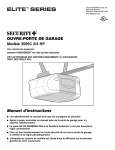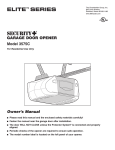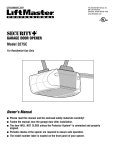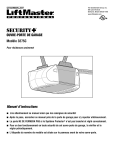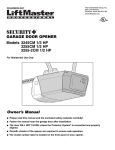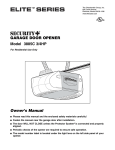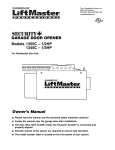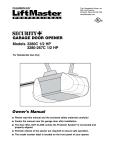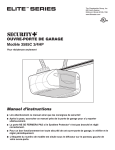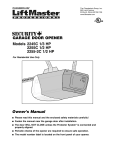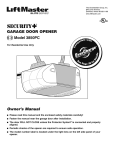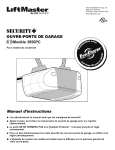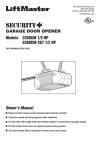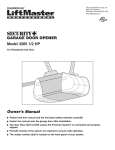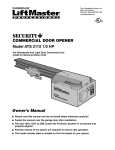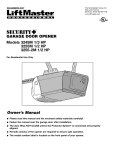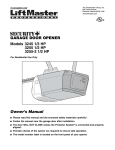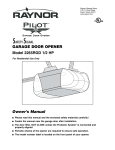Download Chamberlain LIFTMASTER 3265CM User's Manual
Transcript
The Chamberlain Group, Inc. 845 Larch Avenue Elmhurst, Illinois 60126-1196 www.liftmaster.com ® GARAGE DOOR OPENER Models 3265CM 1/2 HP 3265-267CM 1/2 HP For Residential Use Only Owner’s Manual Please read this manual and the enclosed safety materials carefully! Fasten the manual near the garage door after installation. The door WILL NOT CLOSE unless the Protector System® is connected and properly aligned. Periodic checks of the opener are required to ensure safe operation. The model number label is located on the front panel of your opener. TABLE OF CONTENTS Introduction 2-5 Adjustment Safety symbol and signal word review ....................... 2 Preparing your garage door ....................................... 3 Tools needed .............................................................. 3 Planning .................................................................... 4 Carton inventory ......................................................... 5 Hardware inventory .................................................... 5 Assembly Adjust the travel limits .............................................. 23 Adjust the force ........................................................ 24 Test the safety reversal system ................................ 25 Test the Protector System® ..................................... 25 Operation 26-30 Operation safety instructions .................................... 26 Using your garage door opener ............................... 26 Using the wall-mounted door control........................ 27 To open the door manually ....................................... 27 Care of your garage door opener ............................. 28 Having a problem? ................................................... 29 Diagnostic chart ........................................................ 30 6-7 Attach the rail to the motor unit .................................. 6 Attach the chain to the sprocket ................................. 6 Tighten the chain ........................................................ 7 Installation 23-25 7-22 Installation safety instructions .................................... 7 Determine the header bracket location ...................... 8 Install the header bracket ........................................... 9 Attach the rail to the header bracket ........................ 10 Position the opener ...................................................11 Hang the opener....................................................... 12 Install the door control .............................................. 13 Install the light .......................................................... 14 Attach the emergency release rope and handle ...... 14 Electrical requirements ............................................. 15 Install the Protector System®.............................. 16-18 Fasten the door bracket ...................................... 19-20 Connect the door arm to the trolley..................... 21-22 Programming 31-32 To add or reprogram a hand-held remote control .... 31 To erase all codes .................................................... 31 3-Button remotes ...................................................... 31 To add, reprogram or change a Keyless Entry PIN ................................................. 32 Repair Parts 33-34 Rail assembly parts .................................................. 33 Installation parts ....................................................... 33 Motor unit assembly parts ........................................ 34 Accessories 35 Repair Parts and Service 36 Warranty 36 INTRODUCTION Safety Symbol and Signal Word Review This garage door opener has been designed and tested to offer safe service provided it is installed, operated, maintained and tested in strict accordance with the instructions and warnings contained in this manual. When you see these Safety Symbols and Signal Words on the following pages, they will alert you to the possibility of serious injury or death if you do not comply with the warnings that accompany them. The hazard may come from something mechanical or from electric shock. Read the warnings carefully. Mechanical Electrical When you see this Signal Word on the following pages, it will alert you to the possibility of damage to your garage door and/or the garage door opener if you do not comply with the cautionary statements that accompany it. Read them carefully. 2 Preparing your garage door Before you begin: • Disable locks. • Remove any ropes connected to garage door. • Complete the following test to make sure your garage door is balanced and is not sticking or binding: 1. Lift the door about halfway as shown. Release the door. If balanced, it should stay in place, supported entirely by its springs. 2. Raise and lower the door to see if there is any binding or sticking. If your door binds, sticks, or is out of balance, call a trained door systems technician. To prevent possible SERIOUS INJURY or DEATH: • ALWAYS call a trained door systems technician if garage door binds, sticks, or is out of balance. An unbalanced garage door may not reverse when required. • NEVER try to loosen, move or adjust garage door, door springs, cables, pulleys, brackets or their hardware, all of which are under EXTREME tension. • Disable ALL locks and remove ALL ropes connected to garage door BEFORE installing and operating garage door opener to avoid entanglement. To prevent damage to garage door and opener: • ALWAYS disable locks BEFORE installing and operating the opener. • ONLY operate garage door opener at 120V, 60 Hz to avoid malfunction and damage. Sectional Door Tools needed One-Piece Door During assembly, installation and adjustment of the opener, instructions will call for hand tools as illustrated below. Pencil Carpenter’s Level (Optional) 1 2 Hack Saw Tape Measure Wire Cutters Drill Stepladder Claw Hammer 3/16", 5/16" and 5/32" Drill Bits 1/2" and 7/16" Sockets and Wrench Pliers Screwdriver 3 Adjustable End Wrench Planning Identify the type and height of your garage door. Survey your garage area to see if any of the conditions below apply to your installation. Additional materials may be required. You may find it helpful to refer back to this page and the accompanying illustrations as you proceed with the installation of your opener. SECTIONAL DOOR INSTALLATION FINISHED CEILING Support bracket & fastening hardware is required. See page 12. Horizontal and vertical reinforcement is needed for lightweight garage doors (fiberglass, steel, aluminum, door with glass panels, etc.). See page 19 for details. Slack in chain tension is normal when garage door is closed. Header Wall Motor Unit Extension Spring Wallmounted Door Control OR ——— Torsion Spring Vertical Centerline of Garage Door Access Door ——— Safety Reversing Sensor —— Gap between floor and bottom of door must not exceed 1/4" (6 mm). Safety Reversing Sensor FINISHED CEILING ONE-PIECE DOOR WITHOUT TRACK Support bracket & fastening hardware is required. See page 12. Motor Unit Slack in chain tension is normal when garage door is closed. Header Wall ONE-PIECE DOOR WITH TRACK Slack in chain tension is normal when garage door is closed. Wallmounted Door Control Access Door Access Door Safety Reversing Sensor Gap between floor and bottom of door must not exceed 1/4" (6 mm). Safety Reversing Sensor Safety Reversing Sensor 4 Safety Gap between floor Reversing Sensor and bottom of door must not exceed 1/4" (6 mm). Carton Inventory Your garage door opener is packaged in two cartons which contain the motor unit and all parts illustrated below. Accessories will depend on the model purchased. If anything is missing, carefully check the packing material. Parts may be stuck in the foam. Hardware for installation is also listed below. LIGHT Multi-Function Door Control Panel Sprocket Cover SECURITY✚® 3-Button Remote Control 3265C (1) 3265C-267 (2) LOCK SECURITY✚® Keyless Entry 3265C-267 ONLY Chain Styrofoam Motor Unit with Light Lenses CE ILIN G MO UN TO Remote Control Transmitter Visor Clip NLY One-Piece T-rail UP Curved Door Arm Section Header Bracket Trolley 2 Conductor Bell Wire White & White/Red Chain Pulley Bracket Safety Sensor Bracket (2) Door Bracket The Protector System® (2) Safety Reversing Sensors (1 Sending Eye and 1 Receiving Eye) with 2-Conductor White & White/Black Bell Wire attached Safety Labels and Literature INSTALLATION HARDWARE Hex Bolt 5/16"-18x7/8" (4) Lag Screw 5/16"-9x1-5/8" (2) Lag Screw 5/16"-18x1-7/8" (2) Clevis Pin 5/16"x2-3/4" (1) Clevis Pin 5/16"x1-1/4" (1) Clevis Pin 5/16"x1" (1) Nut 5/16"-18 (4) Lock Washer 5/16" (4) Screw 6ABx1-1/4" (2) Screw 6-32x1" (2) Self-Threading Screw 1/4"-14x5/8" (2) Insulated Staples (30) Ring Fastener (3) Drywall Anchors (2) Rail Grease Carriage Bolt 1/4"-20x1/2" (2) Wing Nut 1/4"-20 (2) Rope Handle 5 Straight Door Arm Section ASSEMBLY STEP 1 Attach the Rail to the Motor Unit To avoid SERIOUS damage to garage door opener, use ONLY those bolts/fasteners mounted in the top of the opener. To avoid installation difficulties, do not run the garage door opener until instructed to do so. • Remove the two washered bolts mounted in top of motor unit. • Position rail at a 45˚ angle to opener so one hole in rail and motor unit line up. • Thread one of the washered bolts part way in. Use only these bolts! Use of any other bolts will cause serious damage to door opener. • Align rail and styrofoam over sprocket. Cut tape from rail, chain and styrofoam. • REMOVE STYROFOAM. USE ONLY THIS TYPE AND SIZE BOLT Washered Bolt 5/16"-18x1/2" Styrofoam Rail Hole ASSEMBLY STEP 2 Attach the Chain to the Sprocket and Install the Sprocket Cover To avoid possible serious injury to fingers from moving garage door opener: • ALWAYS keep hand clear of sprocket while operating opener. • Securely attach sprocket cover BEFORE operating. • Position chain over the sprocket. If necessary, loosen the outer nut on the trolley to obtain more chain slack. • Insert the second washered bolt. CAUTION: Use only the bolt previously removed from motor unit! • Tighten both bolts securely through the rail into the motor unit as shown. • Install the sprocket cover: Insert the back tab in the slot. Squeeze the cover slightly and insert the front tab in the slot on the mounting plate. Washered Bolts 5/16"-18x1/2" USE ONLY THIS TYPE AND SIZE BOLT Sprocket Cover Back Tab Slot Front Tab Slot 6 Mounting Plate Sprocket Figure 1 ASSEMBLY STEP 3 Tighten the Chain Outer Nut Lock Washer Inner Nut To Tighten Outer Nut • Spin the inner nut and lock washer down the trolley threaded shaft, away from the trolley. • To tighten the chain, turn outer nut in the direction shown (Figure 1). • When the chain is approximately 1/2" (13 mm) above the base of the rail at its midpoint, re-tighten the inner nut to secure the adjustment. Sprocket noise can result if chain is too loose. When installation is complete, you may notice some chain droop with the door closed. This is normal. If the chain returns to the position shown in Figure 2 when the door is open, do not re-adjust the chain. NOTE: During future maintenance, ALWAYS pull the emergency release handle to disconnect trolley before adjusting chain. NOTE: You may notice loosening of chain after Adjustment Step 3 (Test the Safety Reversal System). Check for proper tension and readjust chain if necessary. Then repeat Adjustment Step 3. You have now finished assembling your garage door opener. Please read the following warnings before proceeding to the installation section. To Tighten Inner Nut Trolley Figure 2 Chain 1/2" (13 mm) Base of Rail Mid Length of Rail WARNING WARNING INSTALLATION IMPORTANT INSTALLATION INSTRUCTIONS WARNING To reduce the risk of SEVERE INJURY or DEATH: 1. READ AND FOLLOW ALL INSTALLATION WARNINGS AND INSTRUCTIONS. 2. Install garage door opener only on properly balanced and lubricated garage door. An improperly balanced door may not reverse when required and could result in SEVERE INJURY or DEATH. 3. All repairs to cables, spring assemblies and other hardware MUST be made by a trained door systems technician BEFORE installing opener. 4. Disable ALL locks and remove ALL ropes connected to garage door BEFORE installing opener to avoid entanglement. 5. Install garage door opener 7 feet (2.13 m) or more above floor. 6. Mount emergency release handle 6 feet (1.83 m) above floor. 7. NEVER connect garage door opener to power source until instructed to do so. 8. NEVER wear watches, rings or loose clothing while installing or servicing opener. They could be caught in garage door or opener mechanisms. 9. Install wall-mounted garage door control: • within sight of the garage door. • out of reach of children at minimum height of 5 feet (1.5 m). • away from ALL moving parts of the door. 10. Place entrapment warning label on wall next to garage door control. 11. Place manual release/safety reverse test label in plain view on inside of garage door. 12. Upon completion of installation, test safety reversal system. Door MUST reverse on contact with a 1-1/2" (3.8 cm) high object (or a 2x4 laid flat) on the floor. 7 INSTALLATION STEP 1 Unfinished Ceiling Determine the Header Bracket Location OPTIONAL CEILING MOUNT FOR HEADER BRACKET 2x4 Header Wall To prevent possible SERIOUS INJURY or DEATH: • Header bracket MUST be RIGIDLY fastened to structural support on header wall or ceiling, otherwise garage door might not reverse when required. DO NOT install header bracket over drywall. • Concrete anchors MUST be used if mounting header bracket or 2x4 into masonry. • NEVER try to loosen, move or adjust garage door, springs, cables, pulleys, brackets, or their hardware, all of which are under EXTREME tension. • ALWAYS call a trained door systems technician if garage door binds, sticks, or is out of balance. An unbalanced garage door might not reverse when required. Vertical Centerline of Garage Door 2x4 Structural Supports Level (optional) Installation procedures vary according to garage door types. Follow the instructions which apply to your door. 1. Close the door and mark the inside vertical centerline of the garage door. 2. Extend the line onto the header wall above the door. You can fasten the header bracket within 4 feet (1.22 m) of the left or right of the door center only if a torsion spring or center bearing plate is in the way; or you can attach it to the ceiling (see page 9) when clearance is minimal. (It may be mounted on the wall upside down if necessary, to gain approximately 1/2" (1 cm). If you need to install the header bracket on a 2x4 (on wall or ceiling), use lag screws (not provided) to securely fasten the 2x4 to structural supports as shown here and on page 9. 3. Open your door to the highest point of travel as shown. Draw an intersecting horizontal line on the header wall above the high point: • 2" (5 cm) above the high point for sectional door and one-piece door with track. • 8" (20 cm) above the high point for one-piece door without track. This height will provide travel clearance for the top edge of the door. NOTE: If the total number of inches exceeds the height available in your garage, use the maximum height possible, or refer to page 9 for ceiling installation. Header Wall 2" (5 cm) Track Header Wall 2" (5 cm) Highest Point of Travel Track Highest Point of Travel Door Door Sectional door with curved track One-piece door with horizontal track Header Wall Header Wall 8" (20 cm) 8" (20 cm) Door Highest Point of Travel Highest Point of Travel Door Jamb Hardware Pivot One-piece door without track: jamb hardware 8 One-piece door without track: pivot hardware INSTALLATION STEP 2 Install the Header Bracket Wall Mounting Holes You can attach the header bracket either to the wall above the garage door, or to the ceiling. Follow the instructions which will work best for your particular requirements. Do not install the header bracket over drywall. If installing into masonry, use concrete anchors (not provided). CEILING MOUNT ONLY The nail hole is for positioning only. You must use lag screws to mount the header bracket. UP WALL HEADER BRACKET INSTALLATION • Center the bracket on the vertical centerline with the bottom edge of the bracket on the horizontal line as shown (with the arrow pointing toward the ceiling). • Mark the vertical set of bracket holes (do not use the holes designated for ceiling mount). Drill 3/16" pilot holes and fasten the bracket securely to a structural support with the hardware provided. Optional Wall Mounting Holes Vertical Centerline of Garage Door Header Wall G ILIN CE Lag Screws 5/16"-9x1-5/8" NLY TO UN MO UP 2x4 Structural Support Header Bracket Door Spring HARDWARE SHOWN ACTUAL SIZE Horizontal Line Garage Door Highest Point of Garage Door Travel Lag Screw 5/16"-9x1-5/8" CEILING HEADER BRACKET INSTALLATION • Extend the vertical centerline onto the ceiling as shown. • Center the bracket on the vertical mark, no more than 6"(15 cm) from the wall. Make sure the arrow is pointing toward the wall. The bracket can be mounted flush against the ceiling when clearance is minimal. • Mark the side holes. Drill 3/16" pilot holes and fasten bracket securely to a structural support with the hardware provided. Vertical Centerline of Garage Door – Finished Ceiling – Header Bracket Door Spring Ceiling Mounting Holes UP 6" (15 cm) Maximum Vertical Centerline of Garage Door Lag Screws 5/16"-9x1-5/8" CEILING MOUNT ONLY UP Header Wall The nail hole is for positioning only. You must use lag screws to mount the header bracket. Garage Door 9 Vertical Centerline of Garage Door INSTALLATION STEP 3 Attach the Rail to the Header Bracket • Position the opener on the garage floor below the header bracket. Use packing material as a protective base. NOTE: If the door spring is in the way you’ll need help. Have someone hold the opener securely on a temporary support to allow the rail to clear the spring. • Position the rail bracket against the header bracket. • Align the bracket holes and join with a clevis pin as shown. • Insert a ring fastener to secure. Header Wall Header Bracket Chain Pulley Bracket Ring Fastener Header Bracket Rail Clevis Pin 5/16"x2-3/4" Chain Pulley Bracket Rail Garage Door Temporary Support HARDWARE SHOWN ACTUAL SIZE Clevis Pin 5/16"x2-3/4" Ring Fastener 10 INSTALLATION STEP 4 Position the Opener To prevent damage to garage door, rest garage door opener rail on 2x4 placed on top section of door. Follow instructions which apply to your door type as illustrated. SECTIONAL DOOR OR ONE-PIECE DOOR WITH TRACK A 2x4 laid flat is convenient for setting an ideal door-to-rail distance. • Remove foam packaging. • Raise the opener onto a stepladder. You will need help at this point if the ladder is not tall enough. • Open the door all the way and place a 2x4 laid flat on the top section beneath the rail. • If the top section or panel hits the trolley when you raise the door, pull down on the trolley release arm to disconnect inner and outer sections. Slide the outer trolley toward the motor unit. The trolley can remain disconnected until Installation Step 12 is completed. Rail Door 2x4 is used to determine the correct mounting height from ceiling. Trolley Release Arm ENGAGED RELEASED ONE-PIECE DOOR WITHOUT TRACK A 2x4 on its side is convenient for setting an ideal door-to-rail distance. • Remove foam packaging. • Raise the opener onto a stepladder. You will need help at this point if the ladder is not tall enough. • Open the door all the way and place a 2x4 on its side on the top section of the door beneath the rail. • The top of the door should be level with the top of the motor unit. Do not position the opener more than 4" (10 cm) above this point. Header Bracket Top of Door 2x4 is used to determine the correct mounting height from ceiling. 11 INSTALLATION STEP 5 Hang the Opener To avoid possible SERIOUS INJURY from a falling garage door opener, fasten it SECURELY to structural supports of the garage. Concrete anchors MUST be used if installing any brackets into masonry. Three representative installations are shown. Yours may be different. Hanging brackets should be angled (Figure 1) to provide rigid support. On finished ceilings (Figure 2 and Figure 3), attach a sturdy metal bracket to structural supports before installing the opener. This bracket and fastening hardware are not provided. 1. Measure the distance from each side of the motor unit to the structural support. 2. Cut both pieces of the hanging bracket to required lengths. 3. Drill 3/16" pilot holes in the structural supports. 4. Attach one end of each bracket to a support with 5/16"-18x1-7/8" lag screws. 5. Fasten the opener to the hanging brackets with 5/16"-18x7/8" hex bolts, lock washers and nuts. 6. Check to make sure the rail is centered over the door (or in line with the header bracket if the bracket is not centered above the door). 7. Remove the 2x4. Operate the door manually. If the door hits the rail, raise the header bracket. 8. Grease the top and underside of the rail surface where the trolley slides with rail grease. NOTE: DO NOT connect power to opener at this time. Figure 1 Structural Supports Measure Distance Lag Screws 5/16"-18x1-7/8" Bolt 5/16"-18x7/8" Lock Washer 5/16" Nut 5/16"-18 Figure 2 Bracket (Not Provided) Hidden Support FINISHED CEILING Lag Screws 5/16"-18x1-7/8" Bolt 5/16"-18x7/8" Lock Washer 5/16" Nut 5/16"-18 (Not Provided) Bolt 5/16"-18x7/8" Lock Washer 5/16" Nut 5/16"-18 HARDWARE SHOWN ACTUAL SIZE Lag Screw 5/16"-18x1-7/8" Figure 3 Lag Screws 5/16"-18x1-7/8" Hex Bolt 5/16"-18x7/8" FINISHED CEILING Nut 5/16"-18 Lock Washer 5/16" Bolt 5/16"-18x7/8" Lock Washer 5/16" Nut 5/16"-18 12 (Not Provided) Bolt 5/16"-18x7/8" Lock Washer 5/16" Nut 5/16"-18 INSTALLATION STEP 6 Install the Door Control To prevent possible SERIOUS INJURY or DEATH from electrocution: • Be sure power is not connected BEFORE installing door control. • Connect ONLY to 24 VOLT low voltage wires. To prevent possible SERIOUS INJURY or DEATH from a closing garage door: • Install door control within sight of garage door, out of reach of children at a minimum height of 5 feet (1.5 m), and away from ALL moving parts of door. • NEVER permit children to operate or play with door control push buttons or remote control transmitters. • Activate door ONLY when it can be seen clearly, is properly adjusted, and there are no obstructions to door travel. • ALWAYS keep garage door in sight until completely closed. NEVER permit anyone to cross path of closing garage door. Locate door control within sight of door at a minimum height of 5 feet (1.5 m) where small children cannot reach, and away from moving parts of door and door hardware. The installation surface must be smooth and flat. If installing into drywall (Figure 1), drill 5/32" holes and use anchors provided. For pre-wired installations (as in new home construction), it may be mounted to a single gang box (Figure 2). NOTE: After installation, a green or amber indicator light behind the cover will indicate proper connection. If not lit, the Lock and Light features will not function (reverse wires to correct). 1. Strip 7/16" (11 mm) of insulation from one end of bell wire and connect to the two screw terminals on back of door control by color: white wire to WHT and white/red wire to the RED (Figure 3). 2. Remove cover by gently prying at slot in the top of the cover with a small flat head screwdriver (Figure 4). Fasten with 6ABx1-1/4" self-tapping screws (drywall installation) or 6-32x1" machine screws (into gang box) as follows: • Drill and install bottom screw, allowing 1/8" (3 mm) to protrude above wall surface. • Position bottom of door control on screw head and slide down to secure. Adjust screw for snug fit. • Install top screw with care to avoid cracking plastic housing. Do not overtighten. • Insert bottom tabs and snap on cover. NOTE: The push bar may stick if the door control is not mounted on a smooth surface. If a click is not heard when pressing the push bar, loosen the two mounting screws or relocate the door control to a smoother surface. 3. (Standard installation only) Run bell wire up wall and across ceiling to motor unit. Use insulated staples to secure wire in several places. Do not pierce wire with a staple, creating a short or open circuit. 4. Strip 7/16" (11 mm) of insulation from end of bell wire. Connect bell wire to the quick-connect terminals as follows: white to white and white/red to red (Figure 5). NOTE: When connecting multiple door controls to the opener, twist same color wires together. Insert wires into quick-connect holes: white to white and red/white to red. 5. Use tacks or staples to permanently attach entrapment warning label to wall near door control, and manual release/safety reverse test label in a prominent location on inside of garage door. NOTE: DO NOT connect power and operate opener at this time. The trolley will travel to the full open position but will not return to the close position until the sensor beam is connected and properly aligned. HARDWARE SHOWN ACTUAL SIZE Insulated Staples Screw 6ABx1-1/4" (standard installation) Screw 6-32x1" (pre-wired) Figure 1 Drywall Anchors STANDARD INSTALLATION Figure 2 PRE-WIRED INSTALLATION LOCK LIGHT LOCK LIGHT To Replace Insert Bottom Tabs First Figure 3 To Replace Insert Bottom Tabs First MULTI-FUNCTION DOOR CONTROL (BACK) Figure 4 24 Volt 2-Conductor Bell Wire in Gang Box REMOVE COVER Top Mounting Hole Terminal Screws LOCK LIGHT Bell Wire Bottom Mounting Hole Figure 5 Door Control Connections 9 1 7 3 5 KG 9 To release or insert wire, push in tab with screwdriver tip 1 7 3 5 KG Red White Grey 7/16" (11 mm) Strip wire 7/16" (11 mm) 13 INSTALLATION STEP 7 Install the Light To prevent possible OVERHEATING of the endpanel or light socket: • DO NOT use short neck or specialty light bulbs. • DO NOT use halogen bulbs. Use ONLY incandescent. To prevent damage to the opener: • DO NOT use bulbs larger than 100W. • ONLY use A19 size bulbs. • Press the release tabs on both sides of lens. Gently rotate lens back and downward until the lens hinge is in the fully open position. Do not remove the lens. • Install up to a 100 watt maximum light bulb in each socket. Light bulb size should be A19, standard neck only. The light will turn ON and remain lit for approximately 4-1/2 minutes when power is connected. Then the lights will turn OFF. • Reverse the procedure to close the lens. • If the bulbs burn out prematurely due to vibration, replace with a Garage Door Opener bulb. • Use A19, standard neck garage door opener bulbs for replacement. NOTE: Use only standard light bulbs. The use of short neck or speciality light bulbs may overheat the endpanel or light socket. 100 Watt (Max) Standard Light Bulb Release Tab Lens Hinge 100 Watt (Max) Standard Light Bulb INSTALLATION STEP 8 Attach the Emergency Release Rope and Handle To prevent possible SERIOUS INJURY or DEATH from a falling garage door: • If possible, use emergency release handle to disengage trolley ONLY when garage door is CLOSED. Weak or broken springs or unbalanced door could result in an open door falling rapidly and/or unexpectedly. • NEVER use emergency release handle unless garage doorway is clear of persons and obstructions. • NEVER use handle to pull door open or closed. If rope knot becomes untied, you could fall. • Thread one end of the rope through the hole in the top of the red handle so “NOTICE” reads right side up as shown. Secure with an overhand knot at least 1" (2.5 cm) from the end of the rope to prevent slipping. • Thread the other end of the rope through the hole in the release arm of the outer trolley. • Adjust rope length so the handle is 6 feet (1.83 m) above the floor. Ensure that the rope and handle clear the tops of all vehicles to avoid entanglement. Secure with an overhand knot. NOTE: If it is necessary to cut the rope, heat seal the cut end with a match or lighter to prevent unraveling. Overhand Knot Trolley Trolley Release Arm Rope NOT 14 ICE Emergency Release Handle INSTALLATION STEP 9 Electrical Requirements To prevent possible SERIOUS INJURY or DEATH from electrocution or fire: • Be sure power is not connected to the opener, and disconnect power to circuit BEFORE removing cover to establish permanent wiring connection. • Garage door installation and wiring MUST be in compliance with all local electrical and building codes. • NEVER use an extension cord, 2-wire adapter, or change plug in ANY way to make it fit outlet. Be sure the opener is grounded. To avoid installation difficulties, do not run the opener at this time. To reduce the risk of electric shock, your garage door opener has a grounding type plug with a third grounding pin. This plug will only fit into a grounding type outlet. If the plug doesn’t fit into the outlet you have, contact a qualified electrician to install the proper outlet. RIGHT PERMANENT WIRING CONNECTION WRONG If permanent wiring is required by your local code, refer to the following procedure. To make a permanent connection through the 7/8" hole in the top of the motor unit: • Remove the motor unit cover screws and set the cover aside. • Remove the attached 3-prong cord. • Connect the black (line) wire to the screw on the brass terminal; the white (neutral) wire to the screw on the silver terminal; and the ground wire to the green ground screw. The opener must be grounded. • Reinstall the cover. To avoid installation difficulties, do not run the opener at this time. Ground Tab Green Ground Screw Black Wire Ground Wire White Wire 15 Black Wire INSTALLATION STEP 10 Install The Protector System® Be sure power is not connected to the garage door opener BEFORE installing the safety reversing sensor. To prevent SERIOUS INJURY or DEATH from a closing garage door: • Correctly connect and align the safety reversing sensor. This required safety device MUST NOT be disabled. • Install the safety reversing sensor so beam is NO HIGHER than 6" (15 cm) above garage floor. The safety reversing sensor must be connected and aligned correctly before the garage door opener will move in the down direction. IMPORTANT INFORMATION ABOUT THE SAFETY REVERSING SENSOR When properly connected and aligned, the sensor will detect an obstacle in the path of its electronic beam. The sending eye (with an amber indicator light) transmits an invisible light beam to the receiving eye (with a green indicator light). If an obstruction breaks the light beam while the door is closing, the door will stop and reverse to full open position, and the opener lights will flash 10 times. The units must be installed inside the garage so that the sending and receiving eyes face each other across the door, no more than 6" (15 cm) above the floor. Either can be installed on the left or right of the door as long as the sun never shines directly into the receiving eye lens. The mounting brackets are designed to clip onto the track of sectional garage doors without additional hardware. Safety Reversing Sensor 6" (15 cm) max. above floor If it is necessary to mount the units on the wall, the brackets must be securely fastened to a solid surface such as the wall framing. Extension brackets (see accessories) are available if needed. If installing in masonry construction, add a piece of wood at each location to avoid drilling extra holes in masonry if repositioning is necessary. The invisible light beam path must be unobstructed. No part of the garage door (or door tracks, springs, hinges, rollers or other hardware) may interrupt the beam while the door is closing. Safety Reversing Sensor 6" (15 cm) max. above floor Invisible Light Beam Protection Area Facing the door from inside the garage 16 INSTALLING THE BRACKETS Be sure power to the opener is disconnected. Install and align the brackets so the sensors will face each other across the garage door, with the beam no higher than 6" (15 cm) above the floor. They may be installed in one of three ways, as follows. Figure 1 DOOR TRACK MOUNT (RIGHT SIDE) Door Track Lip Garage door track installation (preferred): • Slip the curved arms over the rounded edge of each door track, with the curved arms facing the door. Snap into place against the side of the track. It should lie flush, with the lip hugging the back edge of the track, as shown in Figure 1. If your door track will not support the bracket securely, wall installation is recommended. Indicator Light Sensor Bracket Wall installation (Figure 2 & 3): • Place the bracket against the wall with curved arms facing the door. Be sure there is enough clearance for the sensor beam to be unobstructed. • If additional depth is needed, an extension bracket (See accessories) or wood blocks can be used. • Use bracket mounting holes as a template to locate and drill (2) 3/16" diameter pilot holes on the wall at each side of the door, no higher than 6" (15 cm) above the floor. • Attach brackets to wall with lag screws (Not provided). • If using extension brackets or wood blocks, adjust right and left assemblies to the same distance out from the mounting surface. Make sure all door hardware obstructions are cleared. Figure 2 Lens WALL MOUNT (RIGHT SIDE) ide Ins age r Ga l l Wa Fasten Wood Block to Wall with Lag Screws (Not Provided) Indicator Light Sensor Bracket Lag Screws (Not Provided) Lens Figure 3 WALL MOUNT (RIGHT SIDE) ide Ins age r Ga l l Wa Floor installation (Figure 4): • Use wood blocks or extension brackets (see accessories) to elevate sensor brackets so the lenses will be no higher than 6" (15 cm) above the floor. • Carefully measure and place right and left assemblies at the same distance out from the wall. Be sure all door hardware obstructions are cleared. • Fasten to the floor with concrete anchors as shown. Extension Bracket (See Accessories) (Provided with Extension Bracket) Sensor Bracket (Provided with Extension Bracket) Lens Figure 4 Indicator Light FLOOR MOUNT (RIGHT SIDE) HARDWARE SHOWN ACTUAL SIZE Attach with Concrete Anchors (Not Provided) ide Ins rage a G ll Wa Lens Carriage Bolt 1/4"-20x1/2" Wing Nut 1/4"-20 Staples Indicator Light Sensor Bracket 17 MOUNTING AND WIRING THE SAFETY REVERSING SENSORS • Slide a 1/4"-20x1/2" carriage bolt head into the slot on each sensor. Use wing nuts to fasten sensors to brackets, with lenses pointing toward each other across the door. Be sure the lens is not obstructed by a bracket extension (Figure 5). • Finger tighten the wing nuts. • Run the wires from both sensors to the opener. Use insulated staples to secure wire to wall and ceiling. • Strip 7/16" (11 mm) of insulation from each set of wires. Separate white and white/black wires sufficiently to connect to the opener quick-connect terminals. Twist like colored wires together. Insert wires into quick-connect holes: white to white and white/black to grey (Figure 6). Figure 5 Wing Nut 1/4"-20 Carriage Bolt 1/4"-20x1/2" Lens TROUBLESHOOTING THE SAFETY REVERSING SENSORS 1. If the sending eye indicator light does not glow steadily after installation, check for: • Electric power to the opener. • A short in the white or white/black wires. These can occur at staples, or at opener connections. • Incorrect wiring between sensors and opener. • A broken wire. 2. If the sending eye indicator light glows steadily but the receiving eye indicator light doesn’t: • Check alignment. • Check for an open wire to the receiving eye. 3. If the receiving eye indicator light is dim, realign either sensor. NOTE: When the invisible beam path is obstructed or misaligned while the door is closing, the door will reverse. If the door is already open, it will not close. The opener lights will blink 10 times. See page 16. ALIGNING THE SAFETY REVERSING SENSORS • Plug in the opener. The indicator lights in both the sending and receiving eyes will glow steadily if wiring connections and alignment are correct. The sending eye amber indicator light will glow regardless of alignment or obstruction. If the green indicator light in the receiving eye is off, dim, or flickering (and the invisible light beam path is not obstructed), alignment is required. • Loosen the sending eye wing nut and readjust, aiming directly at the receiving eye. Lock in place. • Loosen the receiving eye wing nut and adjust sensor until it receives the sender’s beam. When the green indicator light glows steadily, tighten the wing nut. Connect Wire to Opener Quick-Connect Terminals Figure 6 Bell Wire Finished Ceiling Bell Wire 1. Strip wire 7/16" (11 mm) 7/16" (11 mm) 2. Twist like colored wires together 3. To insert or release wire, push in tab with screwdriver tip Red White Grey Safety Reversing Sensor Safety Reversing Sensor Invisible Light Beam Protection Area 18 Quick-Connect Terminals INSTALLATION STEP 11 Fasten the Door Bracket Fiberglass, aluminum or lightweight steel garage doors WILL REQUIRE reinforcement BEFORE installation of door bracket. Contact your door manufacturer for reinforcement kit. Follow instructions which apply to your door type as illustrated below or on the following page. A horizontal reinforcement brace should be long enough to be secured to two or three vertical supports. A vertical reinforcement brace should cover the height of the top panel. Figure 1 shows one piece of angle iron as the horizontal brace. For the vertical brace, 2 pieces of angle iron are used to create a U-shaped support. The best solution is to check with your garage door manufacturer for an opener installation door reinforcement kit. NOTE: Many door reinforcement kits provide for direct attachment of the clevis pin and door arm. In this case you will not need the door bracket; proceed to Step 12. Header Bracket Door Bracket Location SECTIONAL DOORS 1. Center the door bracket on the previously marked vertical centerline used for the header bracket installation. Note correct UP placement, as stamped inside the bracket. 2. Position the top edge of the bracket 2"-4" (5-10 cm) below the top edge of the door, OR directly below any structural support across the top of the door. 3. Mark, drill holes and install as follows, depending on your door’s construction: Vertical Centerline of Garage Door HORIZONTAL AND VERTICAL REINFORCEMENT IS NEEDED FOR LIGHTWEIGHT GARAGE DOORS (FIBERGLASS, ALUMINUM, STEEL, DOORS WITH GLASS PANEL, ETC.). (NOT PROVIDED) Figure 1 (Not Provided) Vertical Reinforcement Vertical Reinforcement Metal or light weight doors using a vertical angle iron brace between the door panel support and the door bracket: • Drill 3/16" fastening holes. Secure the door bracket using the two 1/4"-14x5/8" self-threading screws. (Figure 2A) • Alternately, use two 5/16" bolts, lock washers and nuts (not provided). (Figure 2B) Vertical Centerline of Garage Door Vertical Centerline of Garage Door Bolt 5/16"-18x2" UP UP Lock Washer 5/16" Nut 5/16"-18 Door Bracket Self-Threading Screw 1/4"-14x5/8" Metal, insulated or light weight factory reinforced doors: • Drill 3/16" fastening holes. Secure the door bracket using the self-threading screws. (Figure 3) Door Bracket Figure 2B Figure 2A (Not Provided) Wood Doors: • Use top and bottom or side to side door bracket holes. Drill 5/16" holes through the door and secure bracket with 5/16"x2" carriage bolts, lock washers and nuts (not provided). (Figure 4) NOTE: The 1/4"-14x5/8" self-threading screws are not intended for use on wood doors. Inside Edge of Door or Reinforcement Board Bolt 5/16"x2" UP Vertical Centerline of Garage Door UP HARDWARE SHOWN ACTUAL SIZE Self-Threading Screw 1/4"-14x5/8" Self-Threading Screw 1/4"-14x5/8" Figure 3 19 Vertical Centerline of Garage Door Figure 4 ONE-PIECE DOORS Please read and comply with the warnings and reinforcement instructions on the previous page. They apply to one-piece doors also. • Center the door bracket on the top of the door, in line with the header bracket as shown. Mark either the left and right, or the top and bottom holes. • Metal Doors: Drill 3/16" pilot holes and fasten the bracket with the 1/4"-14x5/8" self-threading screws provided. • Wood Doors: Drill 5/16" holes and use 5/16"x2" carriage bolts, lock washers and nuts (not provided) or 5/16"x1-1/2" lag screws (not provided) depending on your installation needs. HARDWARE SHOWN ACTUAL SIZE Self-Threading Screw 1/4"-14x5/8" NOTE: The door bracket may be installed on the top edge of the door if required for your installation. (Refer to the dotted line optional placement drawing.) Self-Threading Screw 1/4"-14x5/8" Header Wall 2x4 Support Finished Ceiling Door Bracket Top of Door (Inside Garage) Top Edge of Door Header Bracket Optional Placement Door Bracket METAL DOOR Optional Placement of Door Bracket Vertical Centerline of Garage Door HORIZONTAL AND VERTICAL REINFORCEMENT IS NEEDED FOR LIGHTWEIGHT GARAGE DOORS (FIBERGLASS, ALUMINUM, STEEL, DOORS WITH GLASS PANEL, ETC.). (NOT PROVIDED) Nut 5/16"-18 Door Bracket Lock Washer 5/16" Top of Door (Inside Garage) Top Edge of Door Optional Placement Carriage Bolt 5/16"x2" (Not Provided) For a door with no exposed framing, or for the optional installation, use lag screws 5/16"x1-1/2" (Not Provided) to fasten door bracket. 20 WOOD DOOR INSTALLATION STEP 12 Inner Trolley Connect Door Arm to Trolley Follow instructions which apply to your door type as illustrated below and on the following page. Outer Trolley SECTIONAL DOORS ONLY Make sure garage door is fully closed. Pull the emergency release handle to disconnect the outer trolley from the inner trolley. Slide the outer trolley back (away from the door) about 2" (5 cm) as shown in Figures 1, 2 and 3. Figure 1: • Fasten straight door arm section to outer trolley with the 5/16"x1" clevis pin. Secure the connection with a ring fastener. • Fasten curved section to the door bracket in the same way, using the 5/16"x1-1/4" clevis pin. Figure 2: • Bring arm sections together. Find two pairs of holes that line up and join sections. Select holes as far apart as possible to increase door arm rigidity. Figure 3, Hole alignment alternative: • If holes in curved arm are above holes in straight arm, disconnect straight arm. Cut about 6" (15 cm) from the solid end. Reconnect to trolley with cut end down as shown. • Bring arm sections together. • Find two pairs of holes that line up and join with bolts, lock washers and nuts. Pull the emergency release handle toward the opener at a 45° angle so that the trolley release arm is horizontal. Proceed to Adjustment Step 1, page 23. Trolley will re-engage automatically when opener is operated. Clevis Pin 5/16"x1" Ring Fastener Emergency Release Handle Door Bracket Straight Door Arm Clevis Pin 5/16"x1-1/4" Curved Door Arm Figure 1 Lock Washers 5/16" Nuts 5/16"-18 Bolts 5/16"-18x7/8" Door Bracket Figure 2 HARDWARE SHOWN ACTUAL SIZE Nut 5/16"-18 Lock Washer 5/16" Lock Washers 5/16" Ring Fastener Nuts 5/16"-18 Clevis Pin 5/16"x1" (Trolley) Clevis Pin 5/16"x1-1/4" (Door Bracket) Hex Bolt 5/16"-18x7/8" Bolts 5/16"-18x7/8" Cut This End Figure 3 21 ALL ONE-PIECE DOORS 1. Assemble the door arm, Figure 4: • Fasten the straight and curved door arm sections together to the longest possible length (with a 2 or 3 hole overlap). • With the door closed, connect the straight door arm section to the door bracket with the 5/16"x1-1/4" clevis pin. • Secure with a ring fastener. 2. Adjustment procedures, Figure 5: • On one-piece doors, before connecting the door arm to the trolley, the travel limits must be adjusted. Limit adjustment screws are located on the left side panel as shown on page 23. Follow adjustment procedures below. • Open door adjustment: decrease UP travel limit - Turn the UP limit adjustment screw counter-clockwise 4 turns. - Press the Door Control push button. The trolley will travel to the fully open position. - Manually raise the door to the open position (parallel to the floor), and lift the door arm to the trolley. The arm should touch the trolley just in back of the door arm connector hole. Refer to the fully open trolley/ door arm positions in the illustration. If the arm does not extend far enough, adjust the limit further. One full turn equals 2" (5 cm) of trolley travel. • Closed door adjustment: decrease DOWN travel limit - Turn the DOWN limit adjustment screw clockwise 4 complete turns. Figure 5 Door Bracket Ring Fastener Lock Washers 5/16" Clevis Pin 5/16"x1-1/4" Nuts 5/16"-18 Straight Arm Bolts 5/16"-18x7/8 Figure 4 Curved Door Arm - Press the Door Control push button. The trolley will travel to the fully closed position. - Manually close the door and lift the door arm to the trolley. The arm should touch the trolley just ahead of the door arm connector hole. Refer to the fully closed trolley/door arm positions in the illustration. If the arm is behind the connector hole, adjust the limit further. One full turn equals 2" (5 cm) of trolley travel. 3. Connect the door arm to the trolley: • Close the door and join the curved arm to the connector hole in the trolley with the remaining clevis pin. It may be necessary to lift the door slightly to make the connection. • Secure with a ring fastener. • Run the opener through a complete travel cycle. If the door has a slight "backward" slant in full open position as shown in the illustration, decrease the UP limit until the door is parallel to the floor. NOTE: When setting the up limit on the following page, the door should not have a "backward" slant when fully open as illustrated below. A slight backward slant will cause unnecessary bucking and/or jerking operation as the door is being opened or closed from the fully open position. Inner Trolley Outer Trolley Door Arm Connector Hole Door Arm Emergency Release Handle Closed Door Inner Trolley Outer Trolley Door Arm Correct Angle Door with Backward Slant (Incorrect) Open Door 22 ADJUSTMENT STEP 1 Adjust the UP and DOWN Travel Limits Without a properly installed safety reversal system, persons (particularly small children) could be SERIOUSLY INJURED or KILLED by a closing garage door. • Incorrect adjustment of garage door travel limits will interfere with proper operation of safety reversal system. • If one control (force or travel limits) is adjusted, the other control may also need adjustment. • After ANY adjustments are made, the safety reversal system MUST be tested. Door MUST reverse on contact with 1-1/2" high (3.8 cm) object (or 2x4 laid flat) on floor. Limit adjustment settings regulate the points at which the door will stop when moving up or down. To operate the opener, press the Door Control push bar. Run the opener through a complete travel cycle. • Does the door open and close completely? • Does the door stay closed and not reverse unintentionally when fully closed? If your door passes both of these tests, no limit adjustments are necessary unless the reversing test fails (Adjustment Step 3, page 25). Adjustment procedures are outlined below. Read the procedures carefully before proceeding to Adjustment Step 2. Use a screwdriver to make limit adjustments. Run the opener through a complete travel cycle after each adjustment. NOTE: Repeated operation of the opener during adjustment procedures may cause the motor to overheat and shut off. Simply wait 15 minutes and try again. NOTE: If anything interferes with the door’s upward travel, it will stop. If anything interferes with the door’s downward travel (including binding or unbalanced doors), it will reverse. To prevent damage to vehicles, be sure fully open door provides adequate clearance. Cover Protection Bolt 2-4" (5-10 cm) HOW AND WHEN TO ADJUST THE LIMITS • If the door does not open completely but opens at least five feet (1.5 m): Increase up travel. Turn the UP limit adjustment screw clockwise. One turn equals 2" (5 cm) of travel. NOTE: To prevent the trolley from hitting the cover protection bolt, keep a minimum distance of 2-4" (5 cm - 10 cm) between the trolley and the bolt. Left Side Panel • If door does not open at least 5 feet (1.5 m): Adjust the UP (open) force as explained in Adjustment Step 2. Limit Adjustment Screws Adjustment Label • If the door does not close completely: Increase down travel. Turn the down limit adjustment screw counterclockwise. One turn equals 2" (5 cm) of travel. If door still won't close completely and the trolley bumps into the pulley bracket (page 4), try lengthening the door arm (page 21) and decreasing the down limit. • If the door reverses when closing and there is no visible interference to travel cycle: If the opener lights are flashing, the Safety Reversing Sensors are either not installed, misaligned, or obstructed. See Troubleshooting, page 18. Test the door for binding: Pull the emergency release handle. Manually open and close the door. If the door is binding or unbalanced, call for a trained door systems technician. If the door is balanced and not binding, adjust the DOWN (close) force. See Adjustment Step 2. • If the opener reverses in fully closed position: Decrease down travel. Turn the down limit adjustment screw clockwise. One turn equals 2" (5 cm) of travel. 23 ADJUSTMENT STEP 2 Adjust the Force Without a properly installed safety reversal system, persons (particularly small children) could be SERIOUSLY INJURED or KILLED by a closing garage door. • Too much force on garage door will interfere with proper operation of safety reversal system. • NEVER increase force beyond minimum amount required to close garage door. • NEVER use force adjustments to compensate for a binding or sticking garage door. • If one control (force or travel limits) is adjusted, the other control may also need adjustment. • After ANY adjustments are made, the safety reversal system MUST be tested. Door MUST reverse on contact with 1-1/2" high (3.8 cm) object (or 2x4 laid flat) on floor. Force adjustment controls are located on the back panel of the motor unit. Force adjustment settings regulate the amount of power required to open and close the door. If the forces are set too light, door travel may be interrupted by nuisance reversals in the down direction and stops in the up direction. Weather conditions can affect the door movement, so occasional adjustment may be needed. The maximum force adjustment range is about 3/4 of a complete turn. Do not force controls beyond that point. Turn force adjustment controls with a screwdriver. NOTE: If anything interferes with the door’s upward travel, it will stop. If anything interferes with the door’s downward travel (including binding or unbalanced doors), it will reverse. HOW AND WHEN TO ADJUST THE FORCES 1. Test the DOWN (close) force • Grasp the door bottom when the door is about halfway through DOWN (close) travel. The door should reverse. Reversal halfway through down travel does not guarantee reversal on a 1-1/2" (3.8 cm) obstruction. See Adjustment Step 3, page 25. If the door is hard to hold or doesn’t reverse, DECREASE the DOWN (close) force by turning the control counterclockwise. Make small adjustments until the door reverses normally. After each adjustment, run the opener through a complete cycle. • If the door reverses during the down (close) cycle and the opener lights aren’t flashing, INCREASE DOWN (close) force by turning the control clockwise. Make small adjustments until the door completes a close cycle. After each adjustment, run the opener through a complete travel cycle. Do not increase the force beyond the minimum amount required to close the door. 2. Test the UP (open) force • Grasp the door bottom when the door is about halfway through UP (open) travel. The door should stop. If the door is hard to hold or doesn’t stop, DECREASE UP (open) force by turning the control counterclockwise. Make small adjustments until the door stops easily and opens fully. After each adjustment, run the opener through a complete travel cycle. • If the door doesn’t open at least 5 feet (1.5 m), INCREASE UP (open) force by turning the control clockwise. Make small adjustments until door opens completely. Readjust the UP limit if necessary. After each adjustment, run the opener through a complete travel cycle. Force Adjustment Controls Back Panel KG KG Antenna FORCE ADJUSTMENT LABEL 9 1 7 3 1 7 3 5 5 KG KG Open Force 24 9 Close Force ADJUSTMENT STEP 3 Test the Safety Reversal System Without a properly installed safety reversal system, persons (particularly small children) could be SERIOUSLY INJURED or KILLED by a closing garage door. • Safety reversal system MUST be tested every month. • If one control (force or travel limits) is adjusted, the other control may also need adjustment. • After ANY adjustments are made, the safety reversal system MUST be tested. Door MUST reverse on contact with 1-1/2" high (3.8 cm) object (or 2x4 laid flat) on the floor. TEST • With the door fully open, place a 1-1/2" (3.8 cm) board (or a 2x4 laid flat) on the floor, centered under the garage door. • Operate the door in the down direction. The door must reverse on striking the obstruction. ADJUST • If the door stops on the obstruction, it is not traveling far enough in the down direction. Increase the DOWN limit by turning the DOWN limit adjustment screw counterclockwise 1/4 turn. NOTE: On a sectional door, make sure limit adjustments do not force the door arm beyond a straight up and down position. See the illustration on page 21. • Repeat the test. • When the door reverses on the 1-1/2" (3.8 cm) board, remove the obstruction and run the opener through 3 or 4 complete travel cycles to test adjustment. • If the unit continues to fail the Safety Reverse Test, call for a trained door systems technician. IMPORTANT SAFETY CHECK: Test the Safety Reverse System after: • Each adjustment of door arm length, limits, or force controls. • Any repair to or adjustment of the garage door (including springs and hardware). • Any repair to or buckling of the garage floor. • Any repair to or adjustment of the opener. 1-1/2" (3.8 cm) board (or a 2x4 laid flat) ADJUSTMENT STEP 4 Test The Protector System® Without a properly installed safety reversing sensor, persons (particularly small children) could be SERIOUSLY INJURED or KILLED by a closing garage door. • Press the remote control push button to open the door. • Place the opener carton in the path of the door. • Press the remote control push button to close the door. The door will not move more than an inch (2.5 cm), and the opener lights will flash. The garage door opener will not close from a remote if the indicator light in either sensor is off (alerting you to the fact that the sensor is misaligned or obstructed). If the opener closes the door when the safety reversing sensor is obstructed (and the sensors are no more than 6" (15 cm) above the floor), call for a trained door systems technician. Safety Reversing Sensor 25 Safety Reversing Sensor WARNING OPERATION IMPORTANT SAFETY INSTRUCTIONS WARNING To reduce the risk of SEVERE INJURY or DEATH: 1. READ AND FOLLOW ALL WARNINGS AND INSTRUCTIONS. 2. ALWAYS keep remote controls out of reach of children. NEVER permit children to operate or play with garage door control push buttons or remote controls. 3. ONLY activate garage door when it can be seen clearly, it is properly adjusted, and there are no obstructions to door travel. 4. ALWAYS keep garage door in sight until completely closed. NO ONE SHOULD CROSS THE PATH OF THE MOVING DOOR. 5. NO ONE SHOULD GO UNDER A STOPPED, PARTIALLY OPEN DOOR. 6. If possible, use emergency release handle to disengage trolley ONLY when garage door is CLOSED. Weak or broken springs or unbalanced door could result in an open door falling rapidly and/or unexpectedly. 7. NEVER use emergency release handle unless garage doorway is clear of persons and obstructions. 8. NEVER use handle to pull garage door open or closed. If rope knot becomes untied, you could fall. 9. If one control (force or travel limits) is adjusted, the other control may also need adjustment. 10. After ANY adjustments are made, the safety reversal system MUST be tested. 11. Safety reversal system MUST be tested every month. Garage door MUST reverse on contact with 1-1/2" high (3.8 cm) high object (or a 2x4 laid flat) on the floor. 12. ALWAYS KEEP GARAGE DOOR PROPERLY BALANCED (see page 3). An improperly balanced door may not reverse when required and could result in SEVERE INJURY or DEATH. 13. All repairs to cables, spring assemblies and other hardware, all of which are under EXTREME tension, MUST be made by a trained door systems technician. 14. ALWAYS disconnect electric power to garage door opener BEFORE making ANY repairs or removing covers. 15. SAVE THESE INSTRUCTIONS. 6. If obstructed while opening, the door will stop. 7. If fully open, the door will not close when the beam is broken. The sensor has no effect in the opening cycle. If the sensor is not installed, or is misaligned, the door won’t close from a hand-held remote. However, you can close the door with the Door Control, the Outside Keylock, or Keyless Entry, if you activate them until down travel is complete. If you release them too soon, the door will reverse. The opener lights will turn on under the following conditions: when the opener is initially plugged in; when power is restored after interruption; when the opener is activated. They will turn off automatically after 4-1/2 minutes or provide constant light when the Light feature on the MultiFunction Door Control is activated. Bulb size is A19. Bulb power is 100 watts maximum. Security✚® light feature: Lights will also turn on when someone walks through the open garage door. With a Multi-Function Door Control, this feature may be turned off as follows: With the opener lights off, press and hold the light button for 10 seconds, until the light goes on, then off again. To restore this feature, start with the opener lights on, then press and hold the light button for 10 seconds until the light goes off, then on again. Using Your Garage Door Opener Your Security✚® opener and hand-held remote control have been factory-set to a matching code which changes with each use, randomly accessing over 100 billion new codes. Your opener will operate with up to eight Security✚® remote controls and one Security✚® Keyless Entry System. If you purchase a new remote, or if you wish to deactivate any remote, follow the instructions in the Programming section. Activate your opener with any of the following: • The hand-held Remote Control: Hold the large push button down until the door starts to move. • The wall-mounted Door Control: Hold the push button or bar down until the door starts to move. • The Keyless Entry (See Accessories): If provided with your garage door opener, it must be programmed before use. See Programming. When the opener is activated (with the safety reversing sensor correctly installed and aligned) 1. If open, the door will close. If closed, it will open. 2. If closing, the door will reverse. 3. If opening, the door will stop. 4. If the door has been stopped in a partially open position, it will close. 5. If obstructed while closing, the door will reverse. If the obstruction interrupts the sensor beam, the opener lights will blink for five seconds. 26 B) To operate one door using all three buttons on the hand-held remote: You may program the remote to openthe door with the large button, Open close it with the middle button, and Close Stop stop the door’s movement with the third button. NOTE: If remote is already programmed, you must first erase all codes. See Programming. 1. With the door closed, press and hold the large remote push button. 2. Press and hold the Lock button on the door control. 3. Press and hold the door control push bar. 4. After the opener lights flash, release all buttons. Using the Wall-Mounted Door Control THE MULTI-FUNCTION DOOR CONTROL Press the push button to open or close the door. Press again to reverse the door during the closing cycle or to stop the door while it's opening. Push Button Lock Button LOCK Light Light feature Button Press the Light button to turn the opener light on or off. It will not control the opener lights when the door is in motion. If you turn it on and then activate the opener, the light will remain on for 4-1/2 minutes. Press again to turn it off sooner. The 4-1/2 minute interval can be changed to 1-1/2, 2-1/2, or 3-1/2 minutes as follows: Press and hold the Lock button until the light blinks (about 10 seconds). A single blink indicates that the timer is reset to 1-1/2 minutes. Repeat the procedure and the light will blink twice, resetting the timer to 2-1/2 minutes. Repeat again for a 3-1/2 minute interval, etc., up to a maximum of four blinks and 4-1/2 minutes. LIGHT To Open the Door Manually Lock feature Designed to prevent operation of the door from hand-held remote controls. However, the door will open and close from the Door Control, the Outside Keylock and the Keyless Entry Accessories. To activate, press and hold the Lock button for 2 seconds. The push bar light will flash as long as the Lock feature is on. To turn off, press and hold the Lock button again for 2 seconds.The push bar light will stop flashing. The Lock feature will also turn off whenever the “learn” button on the motor unit panel is activated. To prevent possible SERIOUS INJURY or DEATH from a falling garage door: • If possible, use emergency release handle to disengage trolley ONLY when garage door is CLOSED. Weak or broken springs or unbalanced door could result in an open door falling rapidly and/or unexpectedly. • NEVER use emergency release handle unless garage doorway is clear of persons and obstructions. • NEVER use handle to pull door open or closed. If rope knot becomes untied, you could fall. The door should be fully closed if possible. Pull down on the emergency release handle and lift the door manually. To reconnect the door to the opener, press the door control push bar. Additional features when used with the 3-Button hand-held remote A) To control the opener lights: In addition to operating the door, you may program the remote to operate the lights. 1. With the door closed, press and hold a small remote button that you want to control the light. 2. Press and hold the Light button on the Multi-Function door control. 3. While holding the Light button, press and hold the Lock button on the door control. 4. After the opener lights flash, release all buttons. The lockout feature prevents the trolley from reconnecting automatically. Pull the emergency release handle down and back (toward the opener). The door can then be raised and lowered manually as often as necessary. To disengage the lockout feature, pull the handle straight down. The trolley will reconnect on the next UP or DOWN operation, either manually or by using the door control or remote. 27 Emergency Release Handle (Pull Down) Trolley Release Arm NOT ICE MANUAL DISCONNECT POSITION Trolley Release Arm Emergency Release Handle (Down and Back) NOTICE LOCKOUT POSITION THE REMOTE CONTROL BATTERY CARE OF YOUR OPENER LIMIT AND FORCE ADJUSTMENTS: Weather conditions may cause FORCE CONTROLS some minor changes in door operation requiring some re-adjustments, particularly during the first year of operation. Pages 23 and 24 refer to the limit and force adjustments. Only a LIMIT CONTROLS screwdriver is required. Follow the instructions carefully. Repeat the safety reverse test (Adjustment Step 3, page 25) after any adjustment of limits or force. 9 1 7 3 9 7 5 5 KG KG To prevent possible SERIOUS INJURY or DEATH: • NEVER allow small children near batteries. • If battery is swallowed, immediately notify doctor. To reduce risk of fire, explosion or chemical burn: • Replace ONLY with 3V2032 coin batteries. • Do NOT recharge, disassemble, heat above 100°C (212°F) or incinerate. 1 3 The lithium battery should produce power for up to 5 years. To replace battery, use the visor clip or screwdriver blade to pry open the case as shown. Insert battery positive side up (+). Dispose of old battery properly. Replace the battery with only 3V2032 coin cell batteries. MAINTENANCE SCHEDULE Once a Month • Manually operate door. If it is unbalanced or binding, call a trained door systems technician. • Check to be sure door opens and closes fully. Adjust limits and/or force if necessary. (See pages 23 and 24.) • Repeat the safety reverse test. Make any necessary adjustments. (See Adjustment Step 3.) Battery positive side up (+) NOTICE: To comply with FCC and or Industry Canada (IC) rules, adjustment or modifications of this receiver and/or transmitter are prohibited, except for changing the code setting or replacing the battery. THERE ARE NO OTHER USER SERVICEABLE PARTS. Tested to Comply with FCC Standards FOR HOME OR OFFICE USE. Operation is subject to the following two conditions: (1) this device may not cause harmful interference, and (2) this device must accept any interference received, including interference that may cause undesired operation. Twice a Year • Check chain tension. Disconnect trolley first. Adjust if necessary (See page 7). Once a Year • Oil door rollers, bearings and hinges. The opener does not require additional lubrication. Do not grease the door tracks. 28 HAVING A PROBLEM? 1. My door will not close and the light bulbs blink on my motor unit: The safety reversing sensor must be connected and aligned correctly before the garage door opener will move in the down direction. • Verify the safety sensors are properly installed, aligned and free of any obstructions. Refer to Installation Step 10: Install The Protector System®. • Check diagnostic LED for flashes on the motor unit then refer to the Diagnostic Chart on the following page. Bell Wire Diagnostics Located On Motor Unit LED or Diagnostic LED 2. My remotes will not activate the door: • Verify your Door Control is not blinking. If it is blinking, deactivate the Lock Mode following the instructions for Using the Wall Mounted Door Control. • Reprogram remotes following the programming instructions. Refer to Programming. • If remote will still not activate your door, check diagnostic LED for flashes on motor unit then refer to Diagnostic Chart on the following page. Safety Reversing Sensor Sending Eye Safety Reversing Sensor (Amber Indicator Light) 3. My door reverses for no apparent reason: Repeat safety reverse test after adjustments to force or travel limits. The need for occasional adjustment for the force and limit settings is normal. Weather conditions in particular can affect door travel. • Manually check door for balance or any binding problems. • Refer to Adjustment Step 2, Adjust the Force. “Learn” Button Receiving Eye Safety Reversing Sensor (Green Indicator Light) 6. My motor unit hums briefly: • First verify that the trolley is against the stop bolt. • Release the door from the opener by pulling the Emergency Release Rope. • Manually bring the door to a closed position. • Loosen the chain by adjusting the outer nut 4 to 5 turns. This relieves the tension. • Run the motor unit from the remote control or door control. The trolley should travel towards the door and stop. If the trolley re-engages with the door, pull the Emergency Release Rope to disengage. • Decrease the UP travel by turning the UP Travel adjustment screw 2 full turns away from the arrow. • Re-tighten the outer nut so the chain is a 1/2" (13 mm) above the base of the rail. (When the door is reconnected and closed, the chain will sag. This is normal.) • If the trolley does not move away from the bolt, repeat the steps above. 4. My door reverses for no apparent reason after fully closing and touching the floor: Repeat safety reverse test after adjustments to force or travel limits. The need for occasional adjustment for the force and limit settings is normal. Weather conditions in particular can affect door travel. • Refer to Adjustment Step 1, Adjust the UP and DOWN Travel Limits. Decrease down travel by turning down limit adjustment screw clockwise. 5. My lights will not turn off when door is open: • The garage door opener is equipped with a security light feature. This feature activates the light on when the safety sensor beam has been obstructed. Refer to Operation section; Using the Wall Mounted Door Control, Light Feature. 29 Bell Wire Diagnostics Located On Motor Unit Installed Safety Reversing Sensor LED or Diagnostic LED Safety Reversing Sensor Diagnostic Chart 1 FLASH Safety reversing sensors wire open (broken or disconnected). OR 2 FLASHES Safety reversing sensors wire shorted or black/ white wire reversed. 3 FLASHES Door control or wire shorted. 4 FLASHES Safety reversing sensors slightly misaligned (dim or flashing LED). 5 FLASHES Motor overheated or possible RPM sensor failure. Unplug to reset. 6 FLASHES Motor Circuit Failure. Replace Receiver Logic Board. “Learn” Button Your garage door opener is programmed with self-diagnostic capabilities. The “Learn” button/diagnostic LED will flash a number of times then pause signifying it has found a potential issue. Consult Diagnostic Chart below. Symptom: One or both of the Indicator lights on the safety sensors do not glow steady. • Inspect sensor wires for a short (staple in wire), correct wiring polarity (black/white wires reversed), broken or disconnected wires, replace/attach as needed. • Disconnect all wires from back of motor unit. • Remove sensors from brackets and shorten sensor wires to 1-2 ft. (30-60 cm) from back each of sensor. • Reattach sending eye to motor unit using shortened wires. If sending eye indicator light glows steadily, attach the receiving eye. • Align sensors, if the indicator lights glow replace the wires for the sensors. If the sensor indicator lights do not light, replace the safety sensors. Symptom: LED is not lit on door control. • Inspect door control/wires for a short (staple in wire), replace as needed. • Disconnect wires at door control, touch wires together. If motor unit activates, replace door control. • If motor unit does not activate, disconnect door control wires from motor unit. Momentarily short across red and white terminals with jumper wire. If motor unit activates, replace door control wires. Symptom: Sending indicator light glows steadily, receiving indicator light is dim or flashing. • Realign receiving eye sensor, clean lens and secure brackets. • Verify door track is firmly secured to wall and does not move. Symptom: Motor has over heated; the motor unit does not operate or trolley is stuck on stop bolt = Motor unit hums briefly; RPM Sensor = Short travel 6-8" (15-20 cm). • Unplug unit to reset. Try to operate motor unit, check diagnostic code. • If it is still flashing 5 times and motor unit moves 6-8" (15-20 cm), replace RPM sensor. • If motor unit doesn’t operate, motor unit is overheated. Wait 30 minutes and retry. If motor unit still will not operate replace logic board. Symptom: Motor unit doesn’t operate. • Replace logic board because motor rarely fails. 30 PROGRAMMING NOTICE: If this Security✚® garage door opener is operated with a non-rolling code transmitter, the technical measure in the receiver of the garage door opener, which provides security against code-theft devices, will be circumvented. The owner of the copyright in the garage door opener does not authorize the purchaser or supplier of the non-rolling code transmitter to circumvent that technical measure. Your garage door opener has already been programmed at the factory to operate with your hand-held remote control. The door will open and close when you press the large push button. Below are instructions for programming your opener to operate with additional Security✚® remote controls. To Add or Reprogram a Hand-held Remote Control USING THE “LEARN” BUTTON USING THE MULTI-FUNCTION DOOR CONTROL 9 1 7 3 5 KG 9 1 7 3 5 KG LOCK LIGHT 1. Press and hold the button on the hand-held remote* that you wish to operate your garage door. 1. Press and release the “learn” button on the motor unit. The learn indicator light will glow steadily for 30 seconds. While holding the remote button, press and hold the LIGHT button on the Multi-Function Door Control. 2. Within 30 seconds, press and hold the button on the hand-held remote* that you wish to operate your garage door. LOCK LIGHT 3. Continue holding both buttons while you press the push bar on the Multi-Function Door Control (all three buttons are held). 3. Release the button when the motor unit lights blink. It has learned the code. If light bulbs are not installed, two clicks will be heard. LOCK LIGHT 4. Release buttons when the motor unit lights blink. It has learned the code. If light bulbs are not installed, two clicks will be heard. To Erase All Codes From Motor Unit Memory *3-Button Remotes If provided with your garage door opener, the large button is factory programmed to operate it. Additional buttons on any Security✚® 3-Button remote or compact remote can be programmed to operate other Security✚® garage door openers. To deactivate any unwanted remote, first erase all codes: Press and hold the “learn” button on motor unit until the learn indicator light goes out (approximately 6 seconds). All previous codes are now erased. Reprogram each remote or keyless entry you wish to use. 31 To Add, Reprogram or Change a Keyless Entry PIN NOTE: Your new Keyless Entry must be programmed to operate your garage door opener. USING THE “LEARN” BUTTON USING THE MULTI-FUNCTION DOOR CONTROL LOCK LIGHT 1. Press and release the “learn” button on motor unit. The learn indicator light will glow steadily for 30 seconds. NOTE: This method requires two people if the Keyless Entry is already mounted outside the garage. 1. Enter a four digit personal identification number (PIN) of your choice on the keypad. Then press and hold ENTER. 2. Within 30 seconds, enter a four digit personal identification number (PIN) of your choice on the keypad. Then press and hold the ENTER button. 2. While holding the ENTER button, press and hold the LIGHT button on the Multi-Function Door Control. 3. Release the button when the motor unit lights blink. It has learned the code. If light bulbs are not installed, two clicks will be heard. LOCK LIGHT 3. Continue holding the ENTER and LIGHT buttons while you press the push bar on the Multi-Function Door Control (all three buttons are held). To change an existing, known PIN LOCK LIGHT 4. Release buttons when the motor unit lights blink. It has learned the code. If light bulbs are not installed, two clicks will be heard. If the existing PIN is known, it may be changed by one person without using a ladder. 1. Press the four buttons for the present PIN, then press and hold the # button. The opener light will blink twice. Release the # button. 2. Press the new 4-digit PIN you have chosen, then press Enter. The motor unit lights will blink once when the PIN has been learned. Test by pressing the new PIN, then press Enter. The door should move. 2. Press the temporary 4-digit PIN you have chosen, then press Enter. The opener light will blink four times. 3. To set the number of hours this temporary PIN will work, press the number of hours (up to 255), then press ✽. OR 3. To set the number of times this temporary PIN will work, press the number of times (up to 255), then press #. The opener light will blink once when the temporary PIN has been learned. Test by pressing the four buttons for the temporary PIN, then press Enter. The door should move. If the temporary PIN was set to a certain number of openings, remember that the test has used up one opening.To clear the temporary password, repeat steps 1-3, setting the number of hours or times to 0 in step 3. To set a temporary PIN You may authorize access by visitors or service people with a temporary 4-digit PIN. After a programmed number of hours or number of accesses, this temporary PIN expires and will no longer open the door. It can be used to close the door even after it has expired. To set a temporary PIN: 1. Press the four buttons for your personal entry PIN (not the last temporary PIN), then press and hold the ✽ button. The opener light will blink three times. Release the button. One Button Close: Opener can be closed by pressing only the ENTER button if the one button close feature has been activated. This feature has been activated at the factory. To activate or deactivate this feature press and hold buttons 1 and 9 for 10 seconds. The keypad will blink twice when the one button close is active. The keypad will blink four times when one button close is deactivated. 32 REPAIR PARTS Rail Assembly Parts 5 1 3 4 2 6 KEY NO. PART NO. 1 2 3 4A1008 41A4813 41A3489 4 1707LMC 1708LMC 1710LMC 41D3484 83A11-2 5 6 DESCRIPTION Master link kit Chain pulley bracket Complete trolley assembly One-piece rail - 7' (2.1 m) One-piece rail - 8' (2.4 m) One-piece rail - 10' (3 m) Full chain assembly Rail grease Installation Parts KEY PART NO. NO. 2 3 1 4 LOCK LIGHT 5 6 NOT 41A5273-1 373LMC 10A20 29B137 41A5047 41A2828 7 8 178B34 41A4353 9 41A5034 10 11 41A5266-1 41B4494-1 12 178B35 ICE 7 8 1 2 3 4 5 6 G LIN CEI NLY TO UN MO UP 9 10 11 12 41A2770-6 114A3646 33 DESCRIPTION Multi-function door control panel 3-Button remote control 3V2032 Lithium battery Remote control visor clip Door bracket w/clevis pin & fastener Emergency release rope & handle assembly Straight door arm section Header bracket w clevis pin & fastener Safety sensor kit (receiving and sending eyes) with 3' (.9 m) 2-conductor bell wire Safety sensor brackets (2) 2-Conductor bell wire, white & white/ red Curved door arm section NOT SHOWN Installation hardware bag (includes hardware listed on page 5). Owner’s manual Motor Unit Assembly Parts 18 1 2 3 6 4 10 17 6 16 5 7 19 11 8 13 9 7 15 14 Brown Wire (Down) Contact LIMIT SWITCH ASSEMBLY DN UP 12 Drive Gear Center Limit Contact KEY PART NO. NO. 1 2 31D380 41C4220A 3 41A2817 4 5 6 7 8 9 10 11 41B4245 41A5484-1 4A1344 108D79 30B532 12A373 41A3150 41D3058 DESCRIPTION Sprocket cover Gear and sprocket assembly Complete with: Spring washer, thrust washer, retaining ring, bearing plate, roll pins (2), drive gear and worm gear, helical gear w/ retainer and grease Drive/worm gear kit w/grease, roll pins (2) Line cord End panel w/all labels Light socket Lens Capacitor Capacitor bracket Terminal block w/screws Universal replacement motor & bracket assembly Complete with: Motor, worm, bracket, bearing assembly, RPM sensor KEY PART NO. NO. 12 13 14 15 16 17 41A5525-1 41A2818 41D3452 41A2822-1 41C4398A 41AC050-2M 18 41C5498 41C5497 19 41D180-1 41A2826 41A2825 34 (Up) Contact Grey Wire Yellow Wire DESCRIPTION Cover Limit switch drive & retainer Limit switch assembly Interrupter cup assembly RPM sensor assembly Receiver logic board assy. Complete with: Logic board, end panel w/all labels, light socket Low voltage wire harness assembly. High voltage wire harness assembly. End panel w/all labels NOT SHOWN Motor shaft bearing kit Opener assembly hardware kit (includes screws not designated by a number in illustration) ACCESSORIES Outside Quick Release: Required for a garage with NO access door. Enables homeowner to open garage door manually from outside by disengaging trolley. 1702LM 373PC SECURITY✚® 3-Button Remote Control: Includes visor clip. 373WC Designer Burled Walnut 3-Button Remote Control with Security✚®: Extension Brackets: (Optional) For safety sensor installation onto the wall or floor. 41A5281 Includes visor clip. 3-Button Security✚® Remote Control: 373LMC 78LMC Multi-Function Door Control Panel: Provides a Lock Feature which prevents operation of garage door opener from portable remotes and a Light Feature for constant light. Includes visor clip. 4-Button Security✚® Remote Control: 374LMC LOCK LIGHT Includes visor clip. 902LMC/ 903LMC 377LMC 2 & 3 Door Multi-Function Wall Control: Ideal for homes with up to three garage doors. Combine up to three controls into one wall control panel for a neat compact appearance. Enhanced functions include Lock Feature to lock out outside radio signals while you are away from home and turn opener lights on or off from the control panel. Wireless Keyless Entry with Security✚®: Enables homeowner to operate garage door opener from outside by entering a password on a specially designed keyboard. Also can add a temporary password for visitors or service persons. This temporary password can be limited to a programmable number of hours or entries. 916LMC Garage Door Monitor Sensor: Additional accessory sensor for homes with multiple garage doors. 395LMC Remote Light Control: Enables homeowner to turn on a lamp, television or other appliance from their car with their garage door opener remote or from anywhere in their home with an additional LiftMaster Security✚® remote. 370LMC 3-Button Mini-Remote Control with Security✚®: With key ring and fastening strip. 915LMC Garage Door Monitor: Security for the largest door of your home! Tells you if your garage door is open or closed. Monitors up to 4 garage doors by adding additional sensor modules. CLOSED OPEN 975LMC 35 Laser Park Assist: Laser enables homeowners to precisely park vehicles in the garage. LIFTMASTER SERVICE IS ON CALL OUR LARGE SERVICE ORGANIZATION SPANS AMERICA AND CANADA INSTALLATION AND SERVICE INFORMATION IS AS NEAR AS YOUR TELEPHONE. SIMPLY DIAL OUR TOLL FREE NUMBER: HOW TO ORDER REPAIR PARTS Selling prices will be furnished on request or parts will be shipped at prevailing prices and you will be billed accordingly. WHEN ORDERING REPAIR PARTS, ALWAYS GIVE THE FOLLOWING INFORMATION: 1-800-528-9131 • PART NUMBER • PART NAME • MODEL NUMBER ADDRESS ORDERS TO: THE CHAMBERLAIN GROUP, INC. Technical Support Group 6050 S. Country Club Road Tucson, Arizona 85706 www.liftmaster.com For professional installation, parts and service, contact your local LIFTMASTER/CHAMBERLAIN dealer. Look for him in the Yellow Pages, or call our Service number for a list of dealers in your area. SERVICE INFORMATION TOLL FREE NUMBER: 1-800-528-9131 LIFTMASTER ONE-YEAR LIMITED WARRANTY LIFETIME MOTOR LIMITED WARRANTY The Chamberlain Group, Inc. (“Seller”) warrants to the first retail purchaser of this product, for the residence in which this product is originally installed, that it is free from defect in materials and/or workmanship for a period of one year from the date of purchase and that the motor is free from defect in materials and/or workmanship for the lifetime of the product. The proper operation of this product is dependent on your compliance with the instructions regarding installation, operation, maintenance and testing. Failure to comply strictly with those instructions will void this warranty in its entirety. If, during the limited warranty period, this product appears to contain a defect covered by this limited warranty, call 1-800-528-9131, toll free, before dismantling this product. Then send this product, pre-paid and insured, to our service center for warranty repair. You will be advised of shipping instructions when you call. Please include a brief description of the problem and a dated proof-ofpurchase receipt with any product returned for warranty repair. Products returned to Seller for warranty repair, which upon receipt by Seller are confirmed to be defective and covered by this limited warranty, will be repaired or replaced (at Seller’s sole option) at no cost to you and returned pre-paid. Defective parts will be repaired or replaced with new or factory-rebuilt parts at Seller’s sole option. THIS LIMITED WARRANTY IS IN LIEU OF ANY OTHER WARRANTIES, EXPRESS OR IMPLIED, INCLUDING ANY IMPLIED WARRANTY OF MERCHANTABILITY OR FITNESS FOR A PARTICULAR PURPOSE OR OTHERWISE, AND OF ANY OTHER OBLIGATIONS OR LIABILITY ON SELLER’S PART. THIS LIMITED WARRANTY DOES NOT COVER NON-DEFECT DAMAGE, DAMAGE CAUSED BY IMPROPER INSTALLATION, OPERATION OR CARE (INCLUDING, BUT NOT LIMITED TO ABUSE, MISUSE, FAILURE TO PROVIDE REASONABLE AND NECESSARY MAINTENANCE, UNAUTHORIZED REPAIRS OR ANY ALTERATIONS TO THIS PRODUCT), LABOR CHARGES FOR REINSTALLING A REPAIRED OR REPLACED UNIT, REPLACEMENT OF BATTERIES AND LIGHT BULBS OR UNITS INSTALLED FOR NON-RESIDENTIAL USE. THIS LIMITED WARRANTY DOES NOT COVER ANY PROBLEMS WITH, OR RELATING TO, THE GARAGE DOOR OR GARAGE DOOR HARDWARE, INCLUDING BUT NOT LIMITED TO THE DOOR SPRINGS, DOOR ROLLERS, DOOR ALIGNMENT OR HINGES. ANY SERVICE CALL THAT DETERMINES THE PROBLEM HAS BEEN CAUSED BY ANY OF THESE ITEMS COULD RESULT IN A FEE TO YOU. UNDER NO CIRCUMSTANCES SHALL SELLER BE LIABLE FOR CONSEQUENTIAL, INCIDENTAL OR SPECIAL DAMAGES ARISING IN CONNECTION WITH USE, OR INABILITY TO USE, THIS PRODUCT. IN NO EVENT SHALL SELLER’S LIABILITY FOR BREACH OF WARRANTY, BREACH OF CONTRACT, NEGLIGENCE OR STRICT LIABILITY EXCEED THE COST OF THE PRODUCT COVERED HEREBY. NO PERSON IS AUTHORIZED TO ASSUME FOR US ANY OTHER LIABILITY IN CONNECTION WITH THE SALE OF THIS PRODUCT. Some provinces do not allow the exclusion or limitation of consequential, incidental or special damages, so the above limitation or exclusion may not apply to you. This limited warranty gives you specific legal rights, and you may also have other rights which vary from province to province. 114A3646 © 2008, The Chamberlain Group, Inc. All Rights Reserved The Chamberlain Group, Inc. 845 Larch Avenue Elmhurst, Illinois 60126-1196 www.liftmaster.com ® OUVRE-PORTE DE GARAGE Modèles 3265CM 1/2 HP 3265-267CM 1/2 HP Pour résidences seulement Manuel d’instructions Lire attentivement ce manuel ainsi que les consignes de sécurité! Après la pose, accrocher ce manuel près de la porte de garage pour s’y reporter ultérieurement. La porte NE SE FERMERA PAS si le Système Protector® n’est pas branché et réglé correctement. Pour un bon fonctionnement en toute sécurité de cet ouvre-porte de garage, le vérifier et le régler périodiquement. L’étiquette du numéro de modèle est située sur le panneau avant de votre ouvreporte. TABLE DES MATIÈRES Introduction 2-5 Réglages Revue des symboles de sécurité et des mots de signalement . . . . . . . . . . . . . . . . . . . . . . . . . . . . . . . . . . 2 Préparation de votre porte de garage . . . . . . . . . . . . . . . . 3 Outils nécessaires . . . . . . . . . . . . . . . . . . . . . . . . . . . . . . . 3 Planification . . . . . . . . . . . . . . . . . . . . . . . . . . . . . . . . . . . . 4 Inventaire de la boîte d’emballage . . . . . . . . . . . . . . . . . . . 5 Inventaire des fixations. . . . . . . . . . . . . . . . . . . . . . . . . . . . 5 Montage Fonctionnement 26-30 Instructions de fonctionnement en toute sécurité . . . . . . 26 Utilisation de votre ouvre-porte de garage. . . . . . . . . . . . 26 Utilisation de la commande de porte murale. . . . . . . . . . . . 27 Ouverture manuelle de la porte . . . . . . . . . . . . . . . . . . . . 27 Entretien de votre ouvre-porte de garage . . . . . . . . . . . . 28 Défauts de fonctionnement . . . . . . . . . . . . . . . . . . . . . . . 29 Fiche diagnostique . . . . . . . . . . . . . . . . . . . . . . . . . . . . . . 30 6-7 Fixation du rail au moteur. . . . . . . . . . . . . . . . . . . . . . . . . . 6 Fixation de la chaîne au pignon . . . . . . . . . . . . . . . . . . . . . 6 Tension de la chaîne . . . . . . . . . . . . . . . . . . . . . . . . . . . . . 7 Pose 23-25 Réglage des courses . . . . . . . . . . . . . . . . . . . . . . . . . . . . 23 Réglage de la force . . . . . . . . . . . . . . . . . . . . . . . . . . . . . 24 Contrôle du système d’inversion de sécurité . . . . . . . . . . 25 Essai du Système Protector® . . . . . . . . . . . . . . . . . . . . . 25 7-22 Instructions pour une pose en toute sécurité . . . . . . . . . . . . 7 Déterminer l’emplacement du support de linteau. . . . . . . . . 8 Pose du support de linteau . . . . . . . . . . . . . . . . . . . . . . . . 9 Fixation du rail sur le support de linteau . . . . . . . . . . . . . 10 Positionnement de l’ouvre-porte. . . . . . . . . . . . . . . . . . . . 11 Accrochage de l’ouvre-porte . . . . . . . . . . . . . . . . . . . . . . 12 Pose de la commande de porte . . . . . . . . . . . . . . . . . . . . 13 Pose des l’ampoule . . . . . . . . . . . . . . . . . . . . . . . . . . . . . 14 Pose de la corde et de la poignée de déclenchement d’urgence . . . . . . . . . . . . . . . . . . . . . . . . 14 Exigences électriques . . . . . . . . . . . . . . . . . . . . . . . . . . . 15 Pose du Système Protector® . . . . . . . . . . . . . . . . . . . 16-18 Fixation du support de la porte . . . . . . . . . . . . . . . . . 19-20 Fixation de la biellette de la porte au chariot . . . . . . . 21-22 Programmation 31-32 Pour ajouter ou reprogrammer une télécommande à main. . . . . . . . . . . . . . . . . . . . . . . . 31 Pour effacer tous les codes . . . . . . . . . . . . . . . . . . . . . . . 31 Télécommandes à trois boutons . . . . . . . . . . . . . . . . . . . 31 Pour ajouter, reprogrammer ou modifier un NIP d’entrée sans clé . . . . . . . . . . . . . . . . . . 32 Pièces de réparation 33-34 Pièces d’assemblage du rail . . . . . . . . . . . . . . . . . . . . . . 33 Pièces pour la pose . . . . . . . . . . . . . . . . . . . . . . . . . . . . . 33 Pièces d’assemblage du moteur . . . . . . . . . . . . . . . . . . . 34 Accessoires 35 Pièces de réparation et service 36 Garantie 36 INTRODUCTION Revue des symboles de sécurité et des mots de signalement Cet ouvre-porte de garage a été conçu et testé dans le but d’offrir un service sûr à condition qu’il soit installé, utilisé, entretenu et testé en stricte conformité avec les instructions et les avertissements contenus dans le présent manuel. SSEMENT AVERTISSEMENT Lorsque vous verrez ces symboles de sécurité et ces mots de signalement sur les pages suivantes, ils vous aviseront de la possibilité de blessures graves ou de mort si vous ne vous conformez pas aux avertissements qui les accompagnent. Le danger peut provenir de source mécanique ou d’un choc électrique. Lisez attentivement les avertissements. AVERTISSEMENT Mécanique ATTENTION AVERTISSEMENT AVERTISSEMENT Électrique AVERTISSEMENT ATTENTION AVERTISSEMENT AVERTISSEMENT AVERTISSEMENT AVERTISSEMENT Lorsque vous verrez ce mot de signalement sur les pages suivantes, il vous avisera de la possibilité de dommages à votre porte de garage ou ouvre-porte de garage, ou les deux, si vous ne vous conformez pas aux énoncés de mise en garde qui l ’accompagnent. Lisez-les attentivement. AVERTISSEMENT 2 Préparation de votre porte de garage AVERTISSEMENT Avant de commencer : • Désactiver les serrures. • Retirer toute corde raccordée à la porte de garage. • Réaliser le test suivant pour s’assurer que la porte de garage est équilibrée et qu’elle ne force pas : 1. Soulever la porte à moitié, comme illustré, puis la relâcher. Si elle est équilibrée, elle devrait rester en place, entièrement supportée par ses ressorts. 2. Faire monter et descendre la porte pour s’assurer qu’elle ne force pas. Si votre porte force ou est déséquilibrée, appeler un technicien formé en systèmes de porte. Pour prévenir d’éventuelles BLESSURES GRAVES ou LA MORT : • TOUJOURS appeler un technicien formé en systèmes de porte si la porte de garage force ou est déséquilibrée. Une porte de garage déséquilibrée peut ne pas remonter au besoin. • Ne JAMAIS tenter de desserrer, déplacer ou régler la porte de garage ainsi que les ressorts, câbles, poulies, supports de porte ou leurs ferrures de montage, lesquels sont tous sous une tension EXTRÊME. • Désactiver TOUTES les serrures et retirer TOUTES les cordes raccordées à la porte de garage AVANT de poser et d’utiliser l’ouvre-porte de garage afin d’éviter un emmêlement. AVERTISSEMENT AVERTIS ATTENTION AVERTIS AVERTISS AVERTISSEMENT ATTENTION Pour prévenir les dommages à la porte de garage et à l’ouvre-porte : • TOUJOURS désactiver les serrures AVANT de poser et d’utiliser l’ouvre-porte. • Faire fonctionner l’ouvre-porte de garage UNIQUEMENT à une tension de 120 V, 60 Hz pour éviter les défauts de fonctionnement et les dommages. Porte articulée Porte rigide Outils nécessaires Lors de l’assemblage, de la pose et du réglage de l’ouvre-porte, les instructions feront appel aux outils à main illustrés ci-après. Crayon Niveau de menuisier (facultatif) 1 2 Scie à métaux Ruban à mesurer Pince coupante Perceuse Escabeau Forets de 3/16 de po, de 5/16 de po et 5/32 de po Clé à douille et douilles de 1/2 po et 7/16 de po Tournevis 3 Marteau Pince universelle Clé à molette Planification Identifier le type et la hauteur de votre porte de garage. Examiner la région du garage pour noter si l’une des conditions ci-après s’applique à votre installation. Des matériaux supplémentaires peuvent être nécessaires. Il vous sera peut-être utile de vous reporter à cette page et aux illustrations qui l’accompagnent en procédant à la pose de l’ouvre-porte. PLAFOND FINI POSE DE PORTE ARTICULÉE Une cornière et des fixations peuvent être requises. Se reporter à la page 12. Il faudra poser des renforts horizontaux et verticaux dans le cas d'une porte de garage légère (en fibre de verre, en acier, en aluminium, en panneaux de verre, etc.). Se reporter à la page 19 pour plus de détails. Lorsque la porte du garage est fermée, il est normal que la chaîne dessine une courbe. Linteau Moteur Ressort de traction Ressort de torsion OU ——— Commande de porte murale Ligne du centre vertical de la porte de garage Porte d'accès ——— Détecteur inverseur de sécurité —— Détecteur inverseur de sécurité L'espace entre le plancher et le bas de la porte ne doit pas être supérieur à 1/4 po (6 mm). PLAFOND FINI POSE DE PORTE RIGIDE SANS GUIDES Une cornière et des fixations peuvent être requises. Se reporter à la page 12. Moteur Lorsque la porte du garage est fermée, il est normal que la chaîne dessine une courbe. Linteau PORTE RIGIDE AVEC GUIDES Commande de porte murale Lorsque la porte du garage est fermée, il est normal que la chaîne dessine une courbe. Porte d'accès Porte d'accès Détecteur inverseur de sécurité Détecteur inverseur de sécurité L'espace entre le plancher et le bas de la porte ne doit pas dépasser 1/4 po (6 mm). Détecteur inverseur de sécurité L'espace entre le plancher et le bas de la porte ne doit pas être supérieur à 1/4 po (6 mm). Détecteur inverseur de sécurité 4 Inventaire de la boîte d’emballage Votre ouvre-porte de garage est emballé dans deux boîtes qui contiennent le moteur et toutes les pièces illustrées ci-après. Les accessoires dépendront du modèle acheté. S’il manque quoi que ce soit, vérifier soigneusement le matériel d’emballage. Les pièces peuvent être coincées dans la mousse. Les ferrures de montage sont également indiquées ci-après. LIGHT ® Panneau de commande de porte multifonction Carter du pignon Agrafe de pare-soleil pour télécommande LOCK SECURITY✚ Télécommande à trois boutons Modèles 3265C (1) 3265C-267 (2) Chaîne Fil de sonnerie blanc et blanc/rouge à 2 conducteurs Mousse de polystyrène Support de la porte Moteur avec un diffuseurs Rail rigide Biellette courbée SECURITY✚® Système d’ouverture sans clé Modèle 3265C-267 UNIQUEMENT G ILIN CE T UN MO LY ON UP Chariot Support de linteau Support de la poulie de la chaîne Documentation et étiquettes de sécurité Support du détecteur de sécurité (2) The Protector System® (2) Capteurs d'inversion de sécurité (1 œil de transmission et 1 œil de réception) avec fil de sonnerie blanc et blanc/noir à deux conducteurs fixé FIXATIONS DE POSE Agrafes isolées (30) Anneau d’arrêt (3) Chevilles pour murs secs (2) Graisse à rail Boulon à tête bombée et à collet carré 1/4 po-20 x 1/2 po (2) Écrou à oreilles de 1/4 po-20 (2) Corde Poignée Boulon hexagonal de 5/16 po-18 x 7/8 po (4) Tire-fond de 5/16 po -9 x 1-5/8 po (2) Tire-fond de 5/16 po -18 x 1-7/8 po (2) Axe de chape de 5/16 po x 2-3/4 po (1) Axe de chape de 5/16 po x 1-1/4 po (1) Axe de chape de 5/16 po x 1 po (1) Écrou de 5/16 po -18 (4) Rondelle-frein de 5/16 po (4) Vis 6AB x 1-1/4 po (2) Vis 6-32 x 1 po (2) Vis autotaraudeuse 1/4 po -14 x 5/8 po (2) 5 Biellette droite AVERTISSEMENT MONTAGE - 1re OPÉRATION ATTENTION Fixation du rail au moteur Afin d’éviter d’endommager SÉRIEUSEMENT l’ouvre-porte de garage, utiliser UNIQUEMENT les boulons et les fixations montés sur le dessus de l’ouvre-porte. Pour éviter les difficultés pendant la pose, ne faire fonctionner l'ouvre-porte de garage que lorsque cela est expressément indiqué. • Enlever les deux boulons à rondelles montés sur le dessus du moteur. • Placer le rail à un angle de 45˚ de l'ouvre-porte de façon à ce qu’un des trous du rail soit aligné sur un des trous du moteur. • Visser partiellement l'une des boulons à








































































